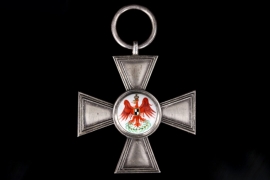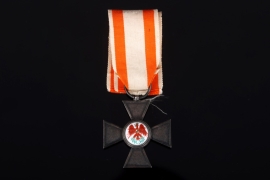Cross 4th Class
MILITARIA PRICE GUIDE / Germany until 1918 / Medals & Decorations / Prussia - Kingdom / Red Eagle Order / 4th Class and Combinations
-
Germany until 1918 (2730)
-
Medals & Decorations (1392)
- Medal bars (179)
- German Empire (117)
- Anhalt - General State (6)
- Anhalt - Köthen (1)
- Baden - Free State of (1)
- Baden - Grand Duchy of (21)
- Bavaria - Free State of (3)
- Bavaria - Kingdom (126)
- Bremen (2)
- Brunswick (16)
- Hamburg (4)
- Hannover (9)
- Hesse - Darmstadt (29)
- Hesse - Kassel (2)
- House of Hohenzollern (5)
- Lippe (8)
- Lübeck (4)
- Mecklenburg-Schwerin - Grand Duchy of (20)
- Mecklenburg-Strelitz - Grand Duchy of (2)
- Nassau (6)
- Oldenburg (18)
- Oldenburg - Free State of (2)
- Prussia - Free State of (2)
-
Prussia - Kingdom (689)
- Civil Honor Decoration (6)
- Long Service Awards (5)
- Military Honor Decorations (566)
- Badge of honor for services to fire extinguishing (2)
- Red Cross Medal (2)
- Merit Cross for Women and Virgins (2)
- Livesaving medals (4)
- Coronation, wedding and commemorative medals (2)
- Merit awards (2)
- Order of Saint John (3)
- Hohenzollersche commemorative coin for 1848/1849 (2)
- Royal House Order of Hohenzollern (10)
- Order of the Crown (32)
- Red Eagle Order (33)
- Order Pour le Mérite (17)
- Order of the Black Eagle (1)
- Reuss (7)
- Saxon duchies from 1826 (17)
- Saxony (36)
- Saxony-Weimar (13)
- Schaumburg Lippe (6)
- Freie Stadt Danzig (2)
- Schwarzburg (6)
- Waldeck (3)
- Württemberg (30)
- Edged weapons (340)
- Headgear (517)
- Uniforms (124)
- Buckles & belts (116)
- Gear (123)
- Porcelain (118)
-
Medals & Decorations (1392)
CONSTRIBUTE TO THIS SITE!
Join our board of authors for articles of historical collectables on a voluntary basis. Click here for more details.
Friedrich Wilhelm II., King of Prussia, resurrected the Brandenburg Red Eagle Order on June 12, 1792, as a single class order. King Friedrich Wilhelm III added a 2nd and 3rd class to the order on January 18, 1810, creating today's well-known design. At first, the decorations of the 2nd and 3rd class were identical in size.
The cross of the order was designed as a Latin cross in white enamel, showing the red Brandenburg eagle on a white enameled center medallion. The reverse medallion showed the cypher “FW” for its founder Friedrich Wilhelm. The star was eight pointed and has a white enameled center showing again the red Brandenburg eagle surrounded by the golden orders motto in between silver pearled rings: “Sincere et constanter” (aufrichtig und beständig), terminated on the bottom by a laurel wreath.
All those who had been awarded the 3rd class before being promoted to the 2nd class of the order received a golden oak leaf attached to the ring of the higher class. This change to the statutes was made on January 18, 1811. Only those knights of the order that received the 3rd and later 2nd class could wear the oak leaf on the 1st class decoration and star.
Inspired by the different sizes of the Russian Order of St. George, the king verbally changed the size of the 3rd class decoration to a smaller version on December 21, 1817.
The structure of the order was amended on January 18, 1832. First, the General Service Cross was promoted into the order, redesigned, and re-named the 4th class Red Eagle Order. Also, the 2nd class could now be awarded with (or without) a newly created star. The rules for the oak leaf applied for the star as well. Finally, the eagle design was changed, by personal intervention of King Friedrich Wilhelm III, to a more pleasing look, which now incorporated the Hohenzollern Coat of Arms.
Analog to the oak leaf, a bow was created on January 22, 1832, to be worn above the ring of the 3rd class of the order by those who had previously been awarded the 4th class.
With King Friedrich Wilhelm III.’s order of January 17, 1846, the 4th class was redesigned and featured from then on an enameled center medallion just like on all higher grades. In addition, the design of the eagle was again updated for all classes.
The swords were created on September 16, 1848, for merit during war and affixed through the medallion. If a recipient was promoted to a higher grade and had been awarded the lower grade with swords, the swords of the lower grade were mounted on the ring of the cross of the higher grade, and on the star (if awarded) above the center medallion.
On February 11, 1850, Crowns and Scepters were awarded to a few recipients who facilitated the suppression of the 1848/49 revolution. Because the revolution was viewed as a heinous, treasonous act, the recipients did not wish to be promoted to a higher grade of the Red Eagle Order for their part in suppressing it. Honoring their wishes, the king awarded the devices as additions to their existing orders.
To honor non-Christian recipients, who were thought to be potentially sensitive to the orders cruciform design, a special star and round design of the Red Eagle Order was created on February 26, 1851.
On December 19, 1851, the king created a special jubilee number to be worn on either the oak leaf or the bow, or as a plaque on the decoration itself, for those celebrating a minimum of 50 year service. For 60 years of service the number “60” was awarded with the Red Eagle Order.
The stars to the 1st and 2nd class were originally embroidered from textile and metal thread. On February 26, 1857, they were ordered made of solid silver and gold. The design differs from the design we know from the last model after July 31, 1854 to approximately the middle of the 1860th.
Numerous complaints from the recipients of the specially designed Red Eagle Order for Non-Christians finally convinced Wilhelm I. to permit recipients to exchange their decorations for those of regular design. On July 5, 1861, Wilhelm I. ordered that, from then on, awards of the Red Eagle Order for Non-Christians were to be made at his personal command only.
As of October 12, 1861, Prussians promoted to a higher grade of the Red Eagle Order who had received swords for bravery on the lower grade, were to wear the oak leaf on the 1st and 2nd class, as well as the bow on the 3rd class, in addition to the swords on ring.
King Wilhelm I. created the Grand Cross of the Red Eagle Order with Star and Collar Chain on Coronation Day, October 18, 1861, in a new and different design to the existing one. The Brandenburg Eagle moved from the center of the order fourfold in between the now Maltese shaped cross arms.
On October 18, 1864, it was ordered that all St. John knights who volunteered to care for the wounded wear a miniature St. John cross on the ring, bow or oak leaf of all Red Eagle Order decorations. This statute was adapted only for the wars in 1864 and 1866.
The manner of wearing the Crown Order and Red Eagle Order simultaneously in the 1st class was redefined on January 18, 1865. Wearing both at the same time was no longer permitted. Instead, recipients were to wear only the order they received first, and an enameled ribbon of the order not worn was affixed around the cross center and the stars medallion. The ribbon of the Red Eagle Order was worn on the Crown Order if the recipient had received the Red Eagle Order first, and vice versa. This custom was abandoned May 4, 1888. From then on, the star of the initially awarded order was not worn anymore but the cross worn on the neck on a narrower ribbon after the statue.
Various changes and adaptations planned by the 99 day emperor Friedrich III. to streamline the Prussian Order system and especially the Red Eagle Order were reverted by Wilhelm II.
With the 100-year jubilee of the creation of the Red Eagle Order in 1892, the crown to the order was created. Wilhelm II. would award the crown personally on special occasions only. However, the crown did not represent another level within the order.
On January 7, 1914, Wilhelm II added the so-called Kleindekoration, a smaller version of the Grand Cross and 1st Class Set. These were to be worn on the coat, mess coat and hunting dress.
With the First World War degenerating into a long and costly trench warfare, precious raw materials grew scarce. Even the materials used for medals and decorations became subject to strict scrutiny. Following similar proclamations in other German states, Prussia mandated that medals and decorations should be made from replacement materials. The General Orders Commission ordered on October 10, 1916, that gold-based decorations should be crafted only from gilt silver with a silver content of 938/1000. By Prussian law those decorations had to be marked with the content mark 938 and the manufacturers control mark. The Prussian Red Eagle Order has compared to all other Prussian and European Orders the most variations within its structure.
| Maker | Date | Price | related products | Show all items | ||||||
|---|---|---|---|---|---|---|---|---|---|---|
|
2024 |

Prussia - red eagle order Cross 4th Class maker Wagner
395
€*
|

|
Cross 4th Class | _Kein Hersteller | 2024 | 03680f23-33d7-11eb-8c0c-305a3a782327 , 200f3951-33d6-11eb-8c0c-305a3a782327 , 600053ff-b6f8-11eb-9c65-305a3a782327 , 6ffa3f67-b6f8-11eb-9c65-305a3a782327 , 8849d122-33d6-11eb-8c0c-305a3a782327 , 88c95bd2-33d6-11eb-8c0c-305a3a782327 , eb2f94fc-33d5-11eb-8c0c-305a3a782327 | c402fcae-d2e2-11ee-aab9-04421a1c88bf | ||||
|
2023 |

Prussia Red Eagle Order 4th Class
650
€*
|

|
Cross 4th Class | _Kein Hersteller | 2023 | 03680f23-33d7-11eb-8c0c-305a3a782327 , 200f3951-33d6-11eb-8c0c-305a3a782327 , 600053ff-b6f8-11eb-9c65-305a3a782327 , 6ffa3f67-b6f8-11eb-9c65-305a3a782327 , 8849d122-33d6-11eb-8c0c-305a3a782327 , 88c95bd2-33d6-11eb-8c0c-305a3a782327 , eb2f94fc-33d5-11eb-8c0c-305a3a782327 | f845caee-b639-11ed-abab-305a3a782327 | ||||
OWN A SIMILAR PRODUCT?
CONSTRIBUTE TO THIS SITE!
Join our board of authors for articles of historical collectables on a voluntary basis. Click here for more details.
This item will be available for buy now on April, 28th. All prices and pictures will be published on 9 pm CEST. Unfortunately, it is not possible to reserve prior to this date.
Many thanks for your patience and understanding.





